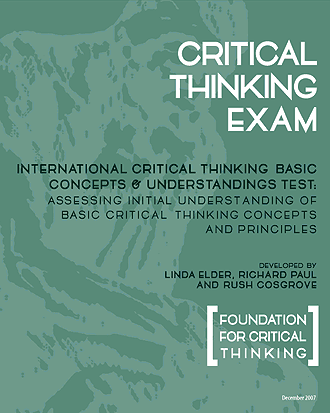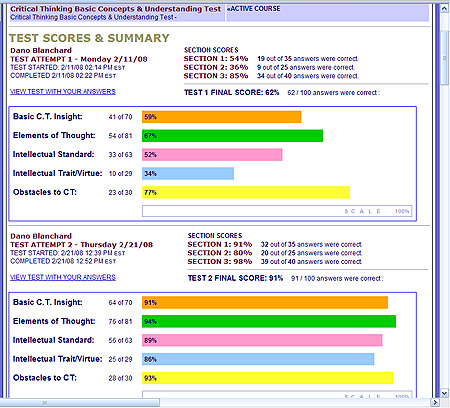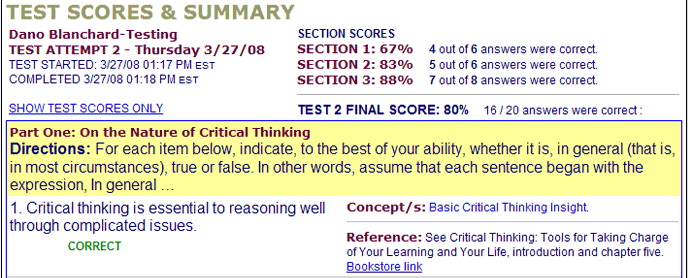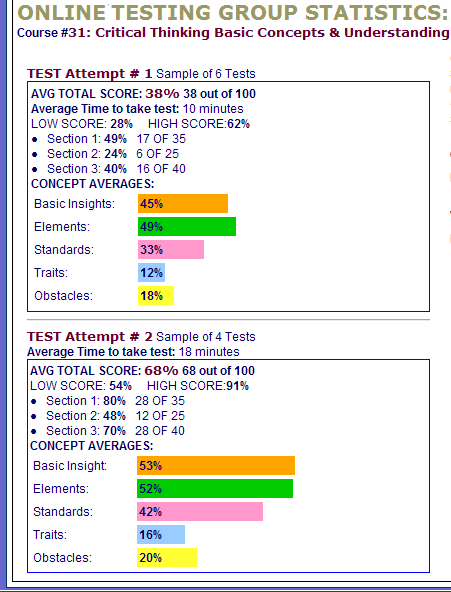 The Online Critical Thinking Basic Concepts Test, developed by leading international authorities on critical thinking, Dr. Linda Elder and Dr. Richard Paul, along with former Foundation for Critical Thinking Research Fellow Dr. Rush Cosgrove, is the first comprehensive and foundational critical thinking concepts and principles test to be developed and offered for online use.
The Online Critical Thinking Basic Concepts Test, developed by leading international authorities on critical thinking, Dr. Linda Elder and Dr. Richard Paul, along with former Foundation for Critical Thinking Research Fellow Dr. Rush Cosgrove, is the first comprehensive and foundational critical thinking concepts and principles test to be developed and offered for online use.
The test is based on the substantive approach to critical thinking developed by Dr. Paul and his colleagues at the Foundation for Critical Thinking over decades of work. It is the only critical thinking test that approaches critical thinking as a trans-disciplinary system of interconnected concepts, principles, and understandings. It focuses on the five essential dimensions of critical thinking:
1. The analysis of thought.
2. The assessment of thought.
3. The dispositions of thought.
4. The skills and abilities of thought.
5. The obstacles or barriers to critical thought.
The test is designed for use at the high school level (grade 10) and above (college, university, and graduate level).
Our online testing software has been custom-developed by the Foundation for Critical Thinking to provide comprehensive grading and reporting for both the student and teacher.
The test measures the extent to which students, faculty, or, indeed, any persons understand the fundamental concepts embedded in critical thinking. A high score provides evidence of the person having done some critical thinking about critical thinking. It implies that the person is more likely to think critically than someone scoring low on the test. It measures, in other words, the necessary understandings for thinking critically. Of course, the test cannot guarantee that persons with basic critical thinking understandings will use them effectively in their lives. No critical thinking test can.
The Online Critical Thinking Basic Concepts Test can assist faculty in determining the extent to which they are succeeding (or not succeeding) in helping students develop the understandings which will enable them to think critically - through course content and through problems and issues they will face in their lives. Most importantly, use of the test, especially when combined with other effective critical thinking assessment approaches, has a high degree of consequential validity. In other words, proper use of the test will lead to greater emphasis on the fundamentals of critical thinking.
For a richer understanding of assessment in critical thinking, see our white paper: Consequential Validity: Using Assessment to Drive Instruction. In this paper, we focus on the primary purpose of assessment in instruction - improvement. The purpose of assessing instruction for critical thinking is to improve the teaching of discipline-based thinking (historical thinking, biological thinking, sociological thinking, mathematical thinking, and so on). It is to improve students’ abilities to think their way through content, problems, and issues using disciplined skill in reasoning. The more particular we can be about what we want students to learn about critical thinking, the better can we devise instruction with that particular end in view. Nothing is more important in this process than our conceptualization of critical thinking, which is why we advocate a substantive, robust, trans-disciplinary conception of critical thinking.
Use of this test can be an important part of the critical thinking assessment process, in providing faculty with data illuminating the extent to which students are learning or have learned the fundamentals of critical thinking. The test may also be used by administrators - for example, in connection with accreditation processes - to assess faculty understanding of critical thinking basic concepts and principles, and therefore readiness to foster critical thinking.
The test provides statistical group data on the test as a whole, as well as on essential critical thinking understandings. It may be used in a pre/post format, and students may retake the test up to eight times with no additional charge per student over a four-year period.
Home study teachers or companies wishing to use the test to assess employee understandings of critical thinking may also benefit from use of the test.
This test is licensed for use only on this website (www.criticalthinking.org). It may not be copied, nor may it be utilized through other distribution methods. The Foundation for Critical Thinking reserves the right to modify the test in any way it deems fit and at any time.
How Is the Test Packaged and Licensed?
This test is sold on a per-student basis, not per test. Each student may take the test up to 8 times over 4 years. We believe that this test is a valuable assessment, learning, and development tool when taken multiple times. Online test results are analyzed and compared over time to show one's progress in understanding core concepts of critical thinking, and to assist in the development of that understanding. We suggest a testing schedule of 2 to 4 times per year in a pre/post test format.
How to Purchase the Test
The test is licensed for Groups and Institutions starting with a minimum of 10 licenses per purchase. There is no setup fee for this test. An administrative account is automatically created upon purchase. Please note the total number of licenses purchased should include one license for the Administrator (e.g. if you have 50 students, you need to purchase 51 licenses in total - one for the Administrator, and one for each student.)
License orders paid by credit card are activated immediately. Payment by other methods, such as purchase order or check, will delay activation of the test account until payment is received by the Foundation for Critical Thinking.
Please note that there is a no-refund policy on our online tests. We therefore highly recommend that you take the sample test before purchasing the full version.
Test Administration and Features
When you purchase test licenses, you are provided a set of tools in your web account to manage your students. The Group Administrator (the account that purchases the test licenses) has access to student rosters, group statistics, and the ability to customize what students can see after taking the test (allowing it to be used for assessment purposes or as online learning tool, depending on the administrator's preference). A student enrollment link is provided for the group administrator to distribute to students, along with a group password. Students are guided through a simple account setup process and then taken directly to the test.
Choosing What Students Can See After They Take the Test
 Following the completion of each test, all students will see a summary of their results. This summary page shows the student's total score, scores by test section, and a graphical display of scores within each of the critical thinking dimensions. A sample screenshot (right) shows the results of two tests taken by a student. This display indicates both the progress made over multiple test attempts and identifies concepts and areas where the student needs improvement.
Following the completion of each test, all students will see a summary of their results. This summary page shows the student's total score, scores by test section, and a graphical display of scores within each of the critical thinking dimensions. A sample screenshot (right) shows the results of two tests taken by a student. This display indicates both the progress made over multiple test attempts and identifies concepts and areas where the student needs improvement.
Test administrators may allow any of the following visibility options to students who take the test:
1. Students may see only whether or not they have answered each question correctly.
2. Students may see only their global scores, as well as their scores on each of these five dimensions of critical thinking:
a. basic critical thinking insights,
b. elements or parts of thinking,
c. intellectual standards,
d. intellectual traits or virtues, and
e. obstacles to critical thinking.
3. Students may see whether or not they answered each question correctly, as well as a reference to where the correct answer can be discovered. (Such references are generally found in the book Critical Thinking: Tools for Taking Charge of Your Learning and Your Life.)
4. Students may see whether or not they answered each question correctly, the correct answer to each question, and a reference to where that answer can be discovered.
The sample screenshot below is taken from the test. This screenshot shows the type of display a student might see. In this case, the correct answer is hidden in accordance with settings chosen by the group administrator; however, the student can still see whether he or she answered each question correctly.

Statistics for Groups and Classes

Administrators are given access to 1) a roster, which displays students' test scores along with links to view indiivdual results, 2) a statistics summary page, and 3) a statistics generation form. The statistics form allows you to compare scores and averages between different test attempts and tests taken at different times. The sample screenshot (right) shows a comparison of student score averages between a pre- and post-test.
A sample of test summary information appears below.
ALL TEST ATTEMPTS: 10 Total Tests taken by 6 Students
Average Score: 50 out of 100 50%
LOW SCORE: 28% HIGH SCORE: 91%
Average Time to take test: 13 minutes
FIRST Test Attempt: 6 tests taken
Average Score: 38 out of 100 38%
LOW SCORE: 28% HIGH SCORE: 62%
Average Time to take test: 10 minutes
SECOND Test Attempt: 4 tests taken
Average Score: 68 out of 100 68%
LOW SCORE: 54% HIGH SCORE: 91%
Average Time to take test: 18 minutes
AVG. Score: IMPROVEMENT OF 30 percentage points from 1st attempt
Low Score: IMPROVEMENT OF 26 percentage points from 1st attempt
High Score: IMPROVEMENT OF 26 percentage points from 1st attempt |
Sample of Summary Statistics
Despite the various customization options offered, administrator and student accounts are easy to set up and use.


{"id":"612","title":"","author":"","content":"<p><img src=\"https://www.criticalthinking.org/image/pimage/Basic-ConceptsCover.gif\" border=\"0\" alt=\"Basic Concepts & Understandings Test\" hspace=\"10\" vspace=\"5\" align=\"right\" /><span>The Online Critical Thinking Basic Concepts Test, developed by <span style=\"text-decoration: underline;\"><strong><a href=\"https://www.criticalthinking.org/pages/our-team-of-presenters/1108\" target=\"_blank\">leading international authorities on critical thinking</a></strong></span>, <span style=\"color: #000000;\">Dr. Linda Elder a</span>nd <span style=\"color: #000000;\">Dr. Richard Paul, along with former Foundation for Critical Thinking Research Fellow Dr. </span><span style=\"color: #000000;\">Rush Cosgrove</span></span><span style=\"color: #000000;\">, is the first comprehensive and foundational critical thinking concepts</span> and principles test to be developed and offered for online use.</p>\r\n<p class=\"F2\"><span> <br /> The test is based on the <span style=\"text-decoration: underline;\"><strong><a href=\"https://www.criticalthinking.org/professionalDev/the-state-ct-today.cfm\" target=\"_blank\">substantive approach to critical thinking</a></strong></span> developed by Dr. Paul and his colleagues at the Foundation for Critical Thinking over decades of work. It is the only critical thinking test that approaches critical thinking as a trans-disciplinary system of interconnected concepts, principles, and understandings. It focuses on the five essential dimensions of critical thinking:<br /><br /> 1. The analysis of thought. <br /> 2. The assessment of thought.<br /> 3. The dispositions of thought.<br /> 4. The skills and abilities of thought.<br /> 5. The obstacles or barriers to critical thought. <br /> </span></p>\r\n<p class=\"F2\"><span> The test is designed for use at the high school level (grade 10) and above (college, university, and graduate level).<br /><br /> Our online testing software has been custom-developed by the Foundation for Critical Thinking to provide comprehensive grading and reporting for both the student and teacher. </span><span><br /> </span><br /> <span>The test measures the extent to which students, faculty, or, indeed, any persons understand the fundamental concepts embedded in critical thinking. A high score provides evidence of the person having done some critical thinking about critical thinking. It implies that the person is more likely to think critically than someone scoring low on the test. It measures, in other words, <em>the necessary understandings for thinking critically</em>. Of course, the test cannot <em>guarantee </em>that persons with basic critical thinking understandings will use them effectively in their lives. No critical thinking test can.<br /> <br /> The Online Critical Thinking Basic Concepts Test can assist faculty in determining the extent to which they are succeeding (or not succeeding) in helping students develop the understandings which will enable them to think critically - through course content and through problems and issues they will face in their lives. Most importantly, use of the test, especially when combined with other effective </span><span>critical thinking </span><span>assessment approaches, has a high degree of <em>consequential validity</em>. In other words, proper use of the test will lead to greater emphasis on the fundamentals of critical thinking. <br /> <br /> For a richer understanding of assessment in critical thinking, see our white paper: <span style=\"text-decoration: underline;\"><strong><a href=\"https://www.criticalthinking.org/files/White%20PaperAssessmentSept2007.pdf\" target=\"_blank\">Consequential Validity: Using Assessment to Drive Instruction</a></strong></span>. In this paper, we focus on the primary purpose of assessment in instruction - improvement. The purpose of assessing instruction for critical thinking is to improve the teaching of discipline-based thinking (historical thinking, biological </span><span><span>thinking</span>, sociological </span><span><span>thinking</span>, mathematical thinking, and so on). It is to improve students’ abilities to think their way through content, problems, and issues using disciplined skill in reasoning. The more particular we can be about what we want students to learn about critical thinking, the better can we devise instruction with that particular end in view. Nothing is more important in this process than our conceptualization of critical thinking, which is why we advocate a substantive, robust, trans-disciplinary conception of critical thinking.<br /> <br /> Use of this test can be an important part of the critical thinking assessment process, in providing faculty with data illuminating the extent to which students are learning or have learned the fundamentals of critical thinking. The test may also be used by administrators - for example, in connection with accreditation processes - to assess faculty understanding of critical thinking basic concepts and principles, and therefore readiness to foster critical thinking.<br /> <br /> The test provides statistical group data on the test as a whole, as well as on essential critical thinking understandings. It may be used in a pre/post format, and students may retake the test up to eight times with no additional charge per student over a four-year period.<br /> <br /> Home study teachers or companies wishing to use the test to assess employee understandings of critical thinking may also benefit from use of the test.<br /> </span> <br /> This test is licensed for use only on this website (www.criticalthinking.org). It may not be copied, nor may it be utilized through other distribution methods. The Foundation for Critical Thinking reserves the right to modify the test in any way it deems fit and at any time.</p>\r\n<hr />\r\n<p><span style=\"color: #000080; font-size: small;\"><strong><br />How Is the Test Packaged and Licensed? </strong></span><br /> <br />This test is sold on a per-student basis, <strong>not </strong>per test. <strong>Each student may take the test up to 8 times over 4 years.</strong> We believe that this test is a valuable assessment, learning, and development tool when taken multiple times. Online test results are analyzed and compared over time to show one's progress in understanding core concepts of critical thinking, and to assist in the development of that understanding. We suggest a testing schedule of 2 to 4 times per year in a pre/post test format. <br /> <br /> <span style=\"color: #000080; font-size: small;\"><strong>How to Purchase the Test</strong></span><br /> <br />The test is licensed for Groups and Institutions starting with a minimum of 10 licenses per purchase. There is <strong>no setup fee</strong> for this test. An administrative account is automatically created upon purchase. Please note the total number of licenses purchased should include one license for the Administrator (e.g. if you have 50 students, you need to purchase 51 licenses in total - one for the Administrator, and one for each student.)</p>\r\n<p><br /> License orders paid by credit card are activated immediately. Payment by other methods, such as purchase order or check, will delay activation of the test account until payment is received by the Foundation for Critical Thinking.</p>\r\n<p><span> <em><br />Please note that there is a no-refund policy on our online tests. We therefore highly recommend that you take the sample test before purchasing the full version.</em></span><span><span><br /> </span> </span></p>\r\n<hr />\r\n<p><span><span class=\"f2\"><strong class=\"head\"><br />Test Administration and Features</strong></span></span><br /><br /><span><span class=\"f2\">When you purchase test licenses, you are provided a set of tools in your web account to manage your students. The Group Administrator (the account that purchases the test licenses) has access to student rosters, group statistics, and the ability to customize what students can see after taking the test (allowing it to be used for assessment purposes or as online learning tool, depending on the administrator's preference). A student enrollment link is provided for the group administrator to distribute to students, along with a group password. Students are guided through a simple account setup process and then taken directly to the test.</span></span></p>\r\n<p><span><strong class=\"head\">Choosing What Students Can See After They Take the Test</strong> <span class=\"f2\"> </span><br /> </span></p>\r\n<p class=\"F2\"><span> <img src=\"https://www.criticalthinking.org/image/pimage/Student_statistics.jpg\" border=\"0\" alt=\"\" hspace=\"10\" vspace=\"5\" align=\"right\" />Following the completion of each test, all students will see a summary of their results. This summary page shows the student's total score, scores by test section, and a graphical display of scores within each of the critical thinking dimensions. A sample screenshot (right) shows the results of two tests taken by a student. This display indicates both the progress made over multiple test attempts and identifies concepts and areas where the student needs improvement.<br /> <br /> Test administrators may allow any of the following visibility options to students who take the test:<br /><br /> 1. Students may see only whether or not they have answered each question correctly.<br /><br /> 2. Students may see only their global scores, as well as their scores on each of these five dimensions of critical thinking:<br /> a. basic critical thinking insights,<br /> b. elements or parts of thinking,<br /> c. intellectual standards,<br /> d. intellectual traits or virtues, and<br /> e. obstacles to critical thinking.<br /><br />3. Students may see whether or not they answered each question correctly, as well as a reference to where the correct answer can be discovered. (Such</span><span><span> references are generally found in the book <span style=\"text-decoration: underline;\"><a href=\"https://www.criticalthinking.org/store-page.cfm?P=products&ItemID=143&catalogID=214&cateID=132\" target=\"_blank\"><em><strong>Critical Thinking: Tools for Taking Charge of Your Learning and Your Life</strong></em></a></span>.)<br /><br /></span>4. Students may see</span><span><span> whether or not they answered each question correctly,</span> the correct answer to each question, and a reference </span><span><span>to where that answer can be discovered.<br /></span><br />The sample screenshot below is taken from the test. This screenshot shows the type of display a student might see. In this case, the correct answer is hidden in accordance with settings chosen by the group administrator; however, the student can still see whether he or she answered each question correctly. <em><br /> </em><br /> </span></p>\r\n<p class=\"F2\"><span><span class=\"f2\"> <img src=\"https://www.criticalthinking.org/image/pimage/Student-results.gif\" border=\"0\" alt=\"Student Test Results Sample Display\" hspace=\"5\" vspace=\"5\" align=\"top\" /> </span></span></p>\r\n<p><span><span class=\"f2\"><strong class=\"head\"><br />Statistics for Groups and Classes</strong> <span class=\"f2\"> </span><br /> <img src=\"https://www.criticalthinking.org/image/pimage/Admin_statistics2.gif\" border=\"0\" alt=\"Statistics\" hspace=\"10\" vspace=\"5\" align=\"right\" /><br /> Administrators are given access to 1) a roster, which displays students' test scores along with links to view indiivdual results, 2) a statistics summary page, and 3) a statistics generation form. The statistics form allows you to compare scores and averages between different test attempts and tests taken at different times. The sample screenshot (right) shows a comparison of student score averages between a pre- and post-test.<br /> <br /> A sample of test summary information appears below.<br /> </span></span></p>\r\n<table border=\"0\" cellspacing=\"1\" cellpadding=\"5\" height=\"214\" bgcolor=\"#ccccff\">\r\n<tbody>\r\n<tr>\r\n<td bgcolor=\"white\"><strong class=\"head\">ALL TEST ATTEMPTS:</strong> <strong>10 </strong>Total Tests taken by <strong>6</strong> Students<br /> <strong>Average Score:</strong> 50 out of 100 50% <br /> LOW SCORE: <strong>28%</strong> HIGH SCORE: <strong>91%</strong> <br /> <strong>Average Time to take test:</strong> 13 minutes \r\n<hr />\r\n<strong class=\"head\">FIRST Test Attempt:</strong> <strong>6</strong> tests taken<br /> <strong>Average Score:</strong> 38 out of 100 <strong>38% </strong><br /> LOW SCORE: <strong>28%</strong> HIGH SCORE: <strong>62%</strong> <br /> <strong>Average Time to take test:</strong> 10 minutes \r\n<hr />\r\n<strong class=\"head\">SECOND Test Attempt:</strong> <strong>4</strong> tests taken<br /> <strong>Average Score:</strong> 68 out of 100 <strong>68% </strong><br /> LOW SCORE: <strong>54%</strong> HIGH SCORE: <strong>91%</strong> <br /> <strong>Average Time to take test:</strong> 18 minutes<br /> <strong>AVG. Score:</strong> IMPROVEMENT OF <strong>30</strong> percentage points from 1st attempt<br /> <strong>Low Score:</strong> IMPROVEMENT OF <strong>26</strong> percentage points from 1st attempt <br /> <strong>High Score:</strong> IMPROVEMENT OF <strong>26</strong> percentage points from 1st attempt</td>\r\n</tr>\r\n</tbody>\r\n<caption><span style=\"color: #000080;\"><strong>Sample of Summary Statistics</strong></span></caption>\r\n</table>\r\n<p><span><span><span class=\"f2\"> <br /> Despite the various customization options offered, administrator and student accounts are easy to set up and use.</span></span></span></p>\r\n<p> </p>\r\n<hr />\r\n<p style=\"text-align: center;\"><span><span><span class=\"f2\"><a href=\"https://www.criticalthinking.org/store-page.cfm?P=products&itemID=303&catalogID=221&cateID=138\" target=\"_blank\"><img style=\"vertical-align: middle; margin-bottom: 15px;\" src=\"https://www.criticalthinking.org/data/courses/Purchase_Test_Licenses_button.jpg\" alt=\"\" width=\"350\" height=\"50\" /></a></span></span></span></p>\r\n<p style=\"text-align: center;\"><span><span><span class=\"f2\"><a href=\"https://www.criticalthinking.org/pages/basic-concepts-sample-test/769\" target=\"_blank\"><img style=\"vertical-align: middle;\" src=\"https://www.criticalthinking.org/data/courses/Try_the_Sample_Test_button.jpg\" alt=\"\" width=\"300\" height=\"49\" /></a> <br /></span></span></span></p>\r\n<hr />\r\n<p> </p>\r\n<p> </p>","public_access":"1","public_downloads":"1","sku":"","files":[],"images":[]}
 The Online Critical Thinking Basic Concepts Test, developed by leading international authorities on critical thinking, Dr. Linda Elder and Dr. Richard Paul, along with former Foundation for Critical Thinking Research Fellow Dr. Rush Cosgrove, is the first comprehensive and foundational critical thinking concepts and principles test to be developed and offered for online use.
The Online Critical Thinking Basic Concepts Test, developed by leading international authorities on critical thinking, Dr. Linda Elder and Dr. Richard Paul, along with former Foundation for Critical Thinking Research Fellow Dr. Rush Cosgrove, is the first comprehensive and foundational critical thinking concepts and principles test to be developed and offered for online use. Following the completion of each test, all students will see a summary of their results. This summary page shows the student's total score, scores by test section, and a graphical display of scores within each of the critical thinking dimensions. A sample screenshot (right) shows the results of two tests taken by a student. This display indicates both the progress made over multiple test attempts and identifies concepts and areas where the student needs improvement.
Following the completion of each test, all students will see a summary of their results. This summary page shows the student's total score, scores by test section, and a graphical display of scores within each of the critical thinking dimensions. A sample screenshot (right) shows the results of two tests taken by a student. This display indicates both the progress made over multiple test attempts and identifies concepts and areas where the student needs improvement.
